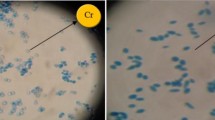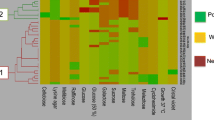Abstract
The composition of wine yeast populations, present during spontaneous fermentation of Chardonnay, Pinot Gris and Riesling from the Lake Erie Region was studied. A combination of biochemical and molecular techniques was used to identify non-Saccharomyces and Saccharomyces yeast isolates. The biochemical techniques included analysis of yeast isolates by sugar fermentation and carbon and nitrogen assimilation. Molecular techniques involved ribotyping of a highly variable segment in the 26S rRNA gene using DNA sequence analysis and restriction fragment length polymorphism of amplified DNA. The results show that of the non-Saccharomyces yeasts, several related species of Hanseniaspora, were the most abundant yeasts present during early stages of fermentation. Later in fermentation S. cerevisiae dominated, and based on biochemical analyses consisted of a heterogeneous group of genotypes. There were no major differences in yeast populations among the three types of juice analyzed.
Similar content being viewed by others
References
Araujo S., Ferrer A., Sulbáran de Ferrer B., Nava C., Ojeda de Rodríguez G. and Nava R.A. 1998. Yeasts isolated from fermenting juice extracted from white-wine grape varieties in Zulia state, Venezuela. Rev. Fac. Agron. 15: 249–255.
Boulton R.B., Singleton V.L., Bisson L.F. and Kunkee R.E. 1996. Principles and practices of winemaking. Aspen Publishers, Gaithersburg, MD.
Ciani M. and Maccarelli F. 1998. Oenological properties of non-Saccharomyces yeasts associated with wine-making. World J. Microbiol. Biotechnol. 14: 199–203.
Ciani M. and Picciotti G. 1995. The growth kinetics and fermentation behavior of some non-Saccharomyces yeasts associated with wine making. Biotech. Lett. 17: 1247–1250.
Degré R., Thomas D.Y., Ash J., Mailhiot K., Morin A. and Dubord C. 1998. Wine yeasts strain identification. Am. J. Enol.Vitic. 40: 309–319.
Fernández M.T., Ubeda J.F. and Briones A.I. 1999. Comparative study of non-Saccharomyces microflora of musts in fermentation, by physiological and molecular methods. FEMS Microbiol. Lett. 173: 223–229.
Fleet G.H. and Heard G.M. 1993. Yeast growth during fermentation. In: Fleet G.H. (ed.), Wine Microbiology and Biotechnology. Harwood Academic Press, Switzerland, pp. 27–75.
Fugelsang K.C. 1997. Wine Microbiology. Chapman & Hall, New York.
Guillamón J.M., Sabate J., Barrio E., Cano J. and Querol A. 1998. Rapid identification of wine yeast species based on RFLP analysis of the ribosomal internal transcribed spacer (ITS) region. Arch. Microbiol. 169: 387–392.
Heard G.M. and Fleet G.H. 1985. Growth of natural yeast flora during the fermentation of inoculated wines. Appl. Environ. Microbiol. 50: 727–728.
Kurtzman C.P. and Robnett C.J. 1998. Identification and phylogeny of ascomycetous yeasts from analysis of nuclear large subunit (26S) ribosomal DNA partial sequences. Antonie van Leeuwenhoek 73: 331–371.
Longo E., Cansado D., Agrelo D. and Villa T.G. 1991. Effect of climatic condition on yeast diversity in grape musts from Northwest Spain. Am. J. Enol. Vitic. 42: 141–144.
Martini A., Ciani M. and Scorzetti G. 1996. Direct enumeration and isolation of wine yeasts from grape surfaces. Am. J. Enol. Vitic. 47: 435–440.
Michot B. and Bachellerie J.-P. 1987. Comparison of large subunit rRNAs reveal some eukaryote-specific elements of secondary structure. Biochimie 69: 11–23.
Mortimer R.K., Romano P., Suzzi G. and Polsinelli M. 1994. Genome renewal: a new phenomenon revealed from a genetic study of 43 strains of Saccharomyces cerevisiae derived from natural fermentation of grape musts. Yeast 10: 1543–1552.
Pardo I., Garcia M.J., Zungina M. and Uruburu F. 1989. Dynamics of microbial populations during fermentation of wines from the Utiel-Requena region of Spain. Appl. Environ. Microbiol. 55: 539–541.
Pramateftaki P.V., Landaris P. and Typas M.A. 2000. Molecular identification of wine yeasts at species or strain level: a case study with strains from two wine growing areas of Greece. J. Appl. Microbiol. 89: 236–248.
Rankine B.C. 1967. Formation of higher alcohols by wine yeasts and relationship to taste threshold. J. Sci. Food Agric. 18: 583–589.
Ribéreau-Gayon P. 1985. New developments in wine microbiology. Am. J. Enol. Vitic. 36: 1–10.
Sambrook J., Fritsch E.F. and Maniatis T. 1989. Molecular Cloning. A Laboratory Manual. Cold Spring Harbor Laboratory Press, Cold Spring Harbor, NY.
Schütz M. and Gafner J. 1993. Analysis of yeast diversity during spontaneous and induced alcoholic fermentations. J. Appl. Bacteriol. 75: 551–557.
Sifritt S.K. 1976. The Ohio wine and wine grape industries, PhD, Kent State University.
Thompson J.D., Higgins D.G. and Gibson T.J. 1994. CLUSTAL W: improving the sensitivity of progressive multiple sequence alignment through sequence weighting, positions-specific gap penalties and weight matrix choice. Nucl. Acids Res. 22: 4673–4680.
Torija M.J., Rozès N., Poblet M., Guillamón J.M. and Mas A. 2001. Yeast population dynamics in spontaneous fermentation: Comparison between two different wine-producing areas over a period of three years. Antonie van Leeuwenhoek 79: 345–352.
Vaughan-Martini A. and Martini A. 1995. Facts, myths and legends on the prime industrial microorganism. J. Ind. Microbiol. 14: 514–522.
Weiss J.B., van Keulen H. and Nash T.E. 1992. Classification of subgroups of Giardia lamblia based upon ribosomal RNA gene sequence using the polymerase chain reaction. Mol. Biochem. Parasitol. 54: 73–86.
Author information
Authors and Affiliations
Corresponding author
Rights and permissions
About this article
Cite this article
van Keulen, H., Lindmark, D.G., Zeman, K.E. et al. Yeasts present during spontaneous fermentation of Lake Erie Chardonnay, Pinot Gris and Riesling. Antonie Van Leeuwenhoek 83, 149–154 (2003). https://doi.org/10.1023/A:1023394914350
Issue Date:
DOI: https://doi.org/10.1023/A:1023394914350




